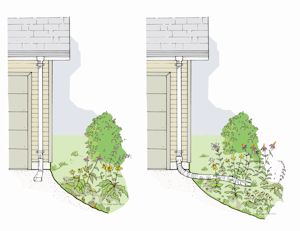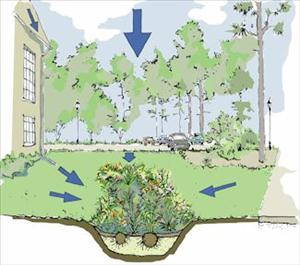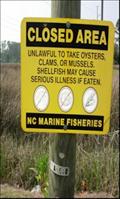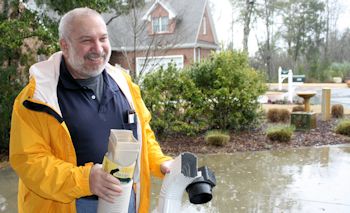 Rerouting downspouts into your yard can cut stormwater runoff from your property in half. |
 Strategically placed rain gardens can act as natural stormwater sinks and be an attractive landscaping amenity. |
Restoring coastal water quality depends on your yard. Did you know that for less than $10 you could cut the polluted stormwater runoff from your property in half? Or that using a rain barrel for lawn irrigation can save you nearly 40 percent on your water bill in the summer?
You can find those tips and others in Smart Yards. The booklet from the N.C. Coastal Federation is a free guide to inexpensive and simple, do-it-yourself solutions to reduce stormwater pollution.
Supporter Spotlight
 Today all five creeks and streams in New Hanover County and 55 percent of the Lockwoods Folly River in Brunswick County are closed to shellfish harvesting because of high levels of bacteria.
Today all five creeks and streams in New Hanover County and 55 percent of the Lockwoods Folly River in Brunswick County are closed to shellfish harvesting because of high levels of bacteria.
“They’ve been polluted to the point that you can’t use them for that one purpose. Some of them you don’t even want to swim in or let your dog swim in,” said Rich Peruggi, a member of the federation board of directors who lives along the Lockwoods Folly and volunteers to build rain gardens to help protect the river. “Most of that damage is attributed in bulk to the pollutants — the bacteria, the fertilizers — that are carried into the stream by the stormwater runoff.”
Whenever a natural area is paved over and replaced with impervious surface, such as a road or parking lot, that prevents the rain from soaking into the ground, the rainwater runs along the hard surface and then usually into a ditch or pipe that carries it to the nearest water body. Along the way that runoff picks up an enormous amount of pollutants and sediment water. Much of that rainwater would have soaked into the sandy soil if the natural environment hadn’t been disrupted.
The federation and partners in 2007 did a three-year quantitative study on how many pollutants reach Lockwoods Folly River in order to begin the process of re-opening closed shellfish waters. Volunteers collected over 300 water samples from 12 sites in the water or on the land that drains into the river. The results found 350 to more than 1,000 fecal coliform colonies on average per 100 milliliters of water. The state’s water quality standard for safe consumption of shellfish is 14 colonies per 100 milliliters of water. This would mean that to preserve the integrity of the water quality, 94 percent of developed land in Brunswick County would need to be targeted for stormwater retrofits.
Regulating point source pollution, like a big pipe at a cement plant, is relatively easy to control unlike non-point sources such as an individual’s driveway. “We need 10,000 small improvements,” said Peruggi.
Supporter Spotlight
Currently the federation is promoting and implementing widespread low-impact development stormwater reduction measures in the Lakes of Lockwood community, located in the Lockwood Folly watershed, as part of a pilot study funded the U.S. Environmental Protection Agency. It will spend a day retrofitting the community with the do-it-yourself solutions highlighted in Smart Yards.
 Rich Peruggi says 10,000 small improvements, like rerouting downspouts, are need to improve water quality in the Lockwoods Folly River. |
“The only way to protect and restore coastal water quality is to maintain or mimic the natural hydrology. And the only way to really accomplish that is to deal with stormwater on a lot-by-lot basis,” said Lauren Kolodij, the federation’s deputy director and creator of Smart Yards.
The goal of Smart Yards is to educate residents about stormwater pollution and to promote the use of soil, plants and rain barrels to capture the rain before it has a chance to become polluted runoff, the way nature intended.
Does your downspout send stormwater onto your driveway? Smart Yards explains how installing a little piping to redirect stormwater five feet from your house onto the grass can make a big difference. A downspout disconnection program in Portland, Ore., reduced 1.2 billion gallons of runoff each year by redirecting 56,000 downspouts in the city.
Or build a rain garden with your neighbors using native plants. Rain gardens function as a bowl, reducing stormwater runoff by 90 percent or more. Plants not only use the water to grow, but their roots create resistance to the flow, prevent erosion and aerate the soil for draining water. What’s more is that native plants require less effort to grow and less money to maintain since they’re conditioned to living in the coastal environment. The Brunswick County Cooperative Extension is a great resource for a list of native plants.
How about saving on 40 percent of your water bill in the summer by using a rain barrel? “It costs money to water a lawn with an irrigation system, but if you’re using a rain barrel to collect the water off your roof, instead of letting it run off your driveway, then you have a free source of water that you can use later on,” said Kolodij.
After reading Smart Yards, you will see solutions to your local watershed problem everywhere you look, whether it’s in your neighbor’s yard or your workplace. The guide is easy to read with bulleted facts, directions, and resources, as well as pictures, diagrams, and examples to support the text. Making a countable difference never seemed so simple.








